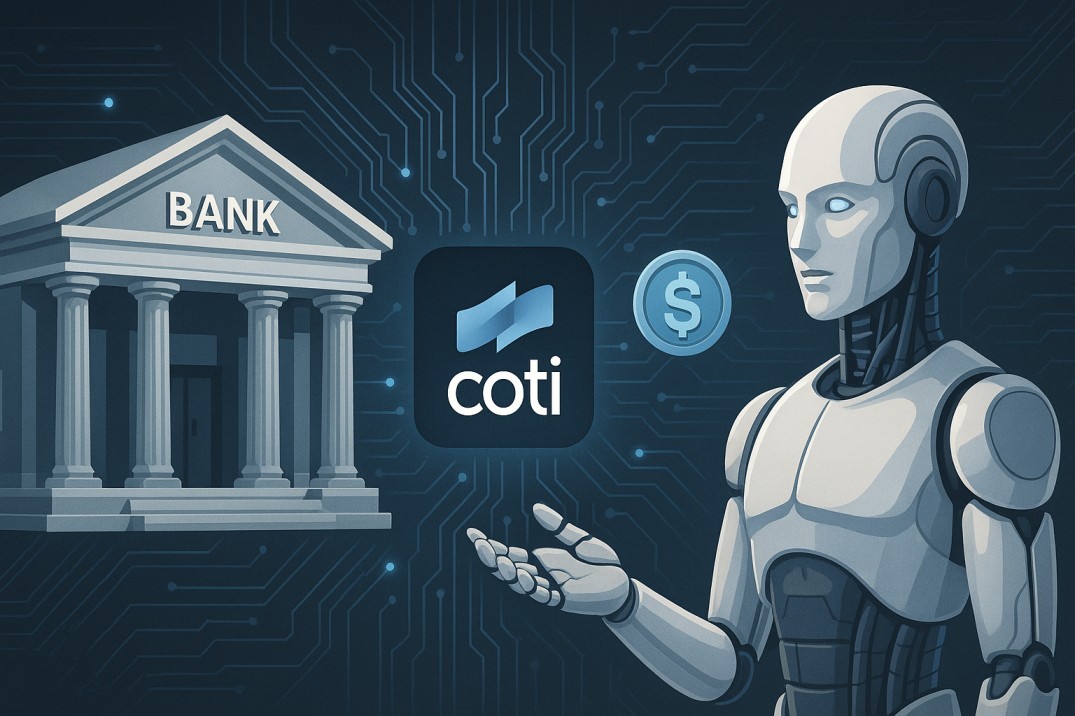TL;DR
- Finance is shifting from human-led to bot-driven: speed, data, automation dominate.
- Privacy and confidentiality become foundational when AI bots transact, decide and settle.
- COTI's architecture uses Garbled Circuits to enable private computation at scale - ideal for AI-driven finance.
- COTI bridges payments, privacy and automation: the three pillars for the next finance stack.
- The biggest use-cases: autonomous lending, high-frequency trading bots, corporate payments, asset tokenization.
- Challenges remain (legacy finance, developer tooling, adoption) but the vision is clear.
- In the age of bots, transparent chains aren't enough - finance needs private, performant rails. COTI is prepared.
As artificial intelligence moves from lab to real-world systems, the finance sector is confronted with a profound transformation. Bank ledgers, payment rails and compliance processes must now adapt to a world where autonomous bots trade, settle and transact in real time - with massive data flows and stringent privacy demands. Traditional financial infrastructure is ill-equipped. Enter COTI: a privacy-centric Layer 2 infrastructure built to handle not only payments, but confidential data-driven finance.
While banks are still upgrading their systems and AI companies are wrestling with data-governance issues, COTI is already laying the foundation for an era of AI-powered finance - where payments, settlements and autonomous agents operate under one hood, intelligently, privately and at scale.
The Pressure on Finance in the AI Era
Financial institutions face a convergence of trends. On one side AI is offering real-time decision making: credit bots assessing risk, trading algorithms executing automatically, lending systems adapting dynamically. On the other side regulatory pressure and privacy demands are intensifying. As one recent paper noted, fintech growth "requires careful attention" to compliance, data-security and auditability.
Classic banking systems were built for batch-processing, human oversight and static data. They weren't designed for thousands of autonomous agents trading, borrowing, shifting assets in micro-seconds. In contrast, AI-bots don't pause for manual checks; they need rapid, private, verifiable rails. The industry faces three key pain points:
- Speed & real-time execution for autonomous agents.
- Confidentiality of data powering decisions (credit history, identity, algorithmic strategies).
- Audit & compliance so regulators, corporations and users can trust the system.
In short: finance must become fast, private and credible - simultaneously.
Why Privacy Becomes Central in AI-Driven Finance

When bots trade, they rely on data. That data may include personal identifiers, credit scores, internal models, counterparty risk profiles. If that data sits on a transparent blockchain, confidentiality evaporates and competitive advantage or personal privacy may be lost. Organizations may refuse to join platforms where their internal logic becomes public.
For AI finance to scale, infrastructure must meet three conditions:
- Confidential data handling - so models, data inputs and execution logic remain hidden when needed.
- Verifiable output - even if inputs are hidden, the outcome must be correct and auditable.
- Scalability and integration - the system must plug into existing finance rails, programming stacks and compliance chains.
This is where COTI's architecture becomes relevant. According to COTI's website:
In other words, COTI is explicitly positioning itself for confidential computing - which aligns neatly with the AI-finance era where data, decisions and settlements all need privacy + performance.
Garbled Circuits: The Engine Under the Hood
The journey toward AI-finance requires a privacy engine. Among cryptographic contenders, garbled circuits (GC) stand out because they allow computations on encrypted inputs while preserving confidentiality. COTI's V2 layer builds on this. As a review in their medium article stated:
In practical terms, this means that an AI-driven credit-engine hosted on COTI could evaluate numerous data points without revealing them to other agents or the public ledger. The output might be a loan approval, executed on-chain, yet none of the sensitive logic is exposed.
For finance, this opens new possibilities:
- Autonomous bots exchanging payment-instructions privately while proving correctness.
- Stable-coins whose issuance logic is confidential, yet auditable.
- Trade settlements where strategy data remains private, settlement flows verifiable.
- AI risk-models running over encrypted data, generating results that trigger on-chain actions - all without exposing inputs.
- From Payments to Autonomous Finance: How COTI Bridges the Gap
COTI's history lies in payments and scalable fintech infrastructure, but with Garbled Circuits it is evolving into something broader: the AI-finance layer. Here's how:
Payments & Fintech Foundation
Originally COTI focused on digital payments, loyalty networks and stable-coins. Its DAG-based architecture and Trustchain protocol served transaction speed and cost efficiency. That foundation is key because payments still remain the bedrock of any financial system.
Privacy and Confidentiality Added
With V2 and garbled circuits, COTI adds confidentiality to that foundation. Not just "send money privately" but "process logic privately." That matters when bots must decide, negotiate and execute.
AI-Ready Infra
AI finance demands data flows between systems, quick confirmations, and on-chain/off-chain hybrids. COTI is architected for this: a private computation layer, EVM-compatibility and scalable throughput. For example, when a trading bot executes a strategy, the submission can be private yet provably valid - no need to reveal algorithm or data.
Compliance Built-In
One barrier for AI finance is regulation: KYC logs, audit trails and transparency. COTI's framework supports selective disclosure: players may reveal only what regulators or counterparties need to see, while hiding internal logic. This balance is rare in blockchain privacy.
Use Case Scenarios: Banks, Bots and the Hybrid Economy

Bot-Driven Lending Protocols
Imagine a lending pool where AI bots analyze risk profiles, make loan offers, and adjust yields continuously. On COTI: the bots' logic is hidden, borrower data remains encrypted, and yet the loans settle on-chain with audit trails for regulators. Privacy meets automation.
Autonomous Trading Agents
High-frequency trading is increasingly algorithmic. On a public chain, strategy transparency is a liability. With COTI, a trading agent executes confidentially, but settlement happens on-chain, and performance proofs are verifiable. The algorithm remains hidden.
Institutional Payments & AI Settlement
Large corporates may automate payroll, rebates or supply-chain finance with bots. They need confidentiality (compensation data, supplier details) plus auditability. COTI enables this: the data stays private, payments settle quickly and the system fits regulatory flows.
Real-World Asset Tokenization with AI Orchestration
Tokenised real-world assets (RWAs) are being managed by AI agents: one bot monitors pricing, another triggers settlement, another distributes revenue. These agents must work with confidential data (contract terms, pricing schedules) yet record on-chain results. COTI supports the "agent → contract → settlement" flow with confidentiality and scalability.
Bigger Picture
The future finance stack will likely look very different. Instead of human-approved actions, autonomous agents will consume, decide and act. Transparency alone won't cut it - neither will full secrecy. What's required is confidential but accountable finance. COTI is carving that space. It isn't just about private money; it's about private logic and private automation. By bridging payments, privacy and autonomous computing, COTI may become the infrastructure layer for the AI-finance economy.
Challenges & What to Keep an Eye On
- Adoption by traditional finance: Banks and institutions are slow. Even if tech is ready, regulatory, cultural and legacy system hurdles remain.
- Complexity for developers: Building AI bots and integrating confidential smart contracts is still new. Developer tooling, documentation and ecosystem growth will matter.
- Competition in the privacy space: While COTI has advantages, other cryptography models (ZK proofs, MPC) may advance rapidly.
- Data governance and identity: AI bots need data. Even if computation is private, data collection and identity management remain complex.
- Token-economics and ecosystem growth: Infrastructure is ready, but the network effect and dApp-ecosystem must follow.
Final Thought
The shift from banks to bots in finance isn't distant - it's already underway. Autonomous agents, real-time settlements, data-driven decisions: they all demand a new infrastructure layer. Transparent blockchains were adequate for the early era; the next era requires confidentiality, scalability, and automation.
COTI doesn't just claim to enable private payments; it offers a full stack where autonomous finance can run privately, performantly and compliantly. As the AI age dawns, the networks that enable confidential, real-time, agent-driven settlement may decide who wins the next wave of Web3. COTI has shown up with the architecture. Now it's time for the world of finance - banks, bots and beyond - to catch up.
ALSO READ: No More Front-Running: Why COTI V2 Might Just Save DeFi











